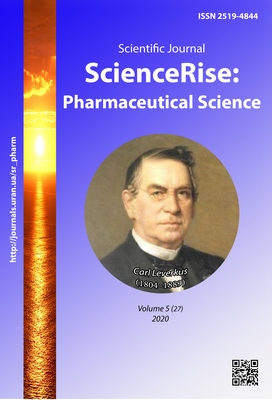Identification and quantitative determination of clonidine by HPLC method
DOI:
https://doi.org/10.15587/2519-4852.2020.215101Keywords:
clonidine hydrochloride, analysis by a unified HPLC methodAbstract
The aim of this work is identification and quantification of clonidine hydrochloride by a unified HPLC method, which allows to obtain reliable and reproducible research results.
Materials and methods. HPLC analysis was carried out on a microcolumn liquid chromatograph "Milichrome A-02" in conditions: reversed-phase variant, column with non-polar sorbent Prontosil 120-5 C18 AQ, 5 μm; mobile phase in the mode of linear gradient – from eluent А (5 % acetonitrile and 95 % buffer solution) to eluent B (100 % acetonitrile) as during 40 min. The flow rate of the mobile phase has been formed 100 μl/min, injection volume – 4 μl. Multichannel detection of the substance was carried out using a UV detector at 210, 220, 230, 240, 250, 260, 280 and 300 nm; the optimal value of column temperature – 37 - 40°С and pressure of pump – 2.8 – 3.2 MPa.
Results and its discussion. As a result of studies using a unified HPLC method, were obtained the retention parameters of clonidine hydrochloride and spectral relationships, which made it possible to include the results obtained in the database for the identification of antihypertensive drugs in the therapeutic monitoring of treatment with an individual drug, or comprehensive treatment of diseases of the cardiovascular system. The development of the quantitative determination of clonidine hydrochloride by HPLC on model solutions using various concentrations of the drug was carried out. The content of clonidine hydrochloride was determined according to the equation S = 0.5 · 10-4 C + 1.8 · 10-3; the correlation coefficient was 0.9964. It is established that the relative uncertainty of the average result did not exceed +2.12 % when HPLC analysing of clonidine hydrochloride in model solutions.
Conclusions. Identification and quantification of clonidine hydrochloride by a unified HPLC method, which allows to obtain reliable and reproducible research results were conducted. The results of research by a unified HPLC method can be recommended for implementation in the practice of forensic bureaus, toxicological centers, clinical laboratories for the study of drugs in biological objects
References
- Mashkovskii, M. D. (2012). Lekarstvennye sredstva. Moscow: Novaia Volna, 1216.
- Clarke, E. J. C. (2011). Isolation and Identification of Drugs in Pharmaceuticals, Body Fluids and Postmortem Materia. London: The Pharm. Press, 2463.
- Wang, J. G., Belley-Coté, E., Burry, L., Duffett, M., Karachi, T., Perri, D. et. al. (2017). Clonidine for sedation in the critically ill: a systematic review and meta-analysis. Critical Care, 21 (1). doi: http://doi.org/10.1186/s13054-017-1610-8
- Hayden, J. C., Bardol, M., Doherty, D. R., Dawkins, I., Healy, M., Breatnach, C. V. et. al. (2019).Optimizing clonidine dosage for sedation in mechanically ventilated children: A pharmacokinetic simulation study. Paediatric Anaesthesia, 29 (10), 1002–1010. doi: http://doi.org/10.1111/pan.13715
- Kowalczyk, W. J., Bertz, J. W., Moran, L. M., Phillips, K. A., Ghitza, U. E., Epstein, D. H., Preston, K. L. (2017). Clonidine Increases the Likelihood That Abstinence Can Withstand Unstructured Time in Buprenorphine-maintained Outpatients. Journal of Addiction Medicine, 11 (6), 454–460. doi: http://doi.org/10.1097/adm.0000000000000345
- Nadzhami, O. L., Orestov, S. M., Klechikov, V. Z. (1995). Posmertnaia diagnostika otravlenii klofelinom: metodicheskoe posobie dlia vrachei-patologoanatomov i sudebno-meditsinskikh ekspertov. Saint Petersburg: Sankt-Peterburgskii gosudarstvennii meditsinskii universitet im. akad. I. P. Pavlova, 15.
- Isbister, G. K., Heppell, S. P., Page, C. B., Ryan, N. M. (2017). Adult clonidine overdose: prolonged bradycardia and central nervous system depression, but not severe toxicity. Clinical Toxicology, 55 (3), 187–192. doi: http://doi.org/10.1080/15563650.2016.1277234
- Cairns, R., Brown, J. A., Buckley, N. A. (2018). Clonidine exposures in children under 6 (2004–2017): a retrospective study. Archives of Disease in Childhood, 104 (3), 287–291. doi: http://doi.org/10.1136/archdischild-2018-316026
- Schmitt, C., Kervégant, M., Ajaltouni, Z., Tauber, M., Tichadou, L., de Haro, L. (2014). Clonidine poisoning in a child: a case report. Archives de Pediatrie, 21 (11), 1213–1215. doi: http://doi.org/10.1016/j.arcped.2014.07.014
- Cates, A. L., Wheatley, S. M., Katz, K. D. (2018). Clonidine Overdose in a Toddler Due to Accidental Ingestion of a Compounding Cream. Pediatric Emergency Care, 34 (4), e79–e81. doi: http://doi.org/10.1097/pec.0000000000000790
- Egorova, A. V., Fedosenko, A. A., Vitiukova, E. O., Kashutskii, S. N., Maltsev, G. V. (2014). Validatsiia metodiki VEZHKH opredeleniia ostatochnykh kolichestv klofelina gidrokhlorida s poverkhnostei farmoborudovaniia. Vіsnik ONU. KHіmіia, 19 (3 (51)), 40–50.
- Derzhavna Farmakopeia Ukrainy. (2011). DP «Naukovo–ekspertnyi farmakopeinyi tsentr». Kharkiv: RIREH, 446–447.
- Tang, F., Bada, H., Ng, C. M., Leggas, M. (2019). Validation of a HPLC/MS method for simultaneous quantification of clonidine, morphine and its metabolites in human plasma. Biomedical Chromatography, 33 (7), e4527. doi: http://doi.org/10.1002/bmc.4527
- De Nicolò, A., Avataneo, V., Rabbia, F., Sciandra, M., Tosello, F., Cusato, J. et .al. (2017). UHPLC–MS/MS method with sample dilution to test therapeutic adherence through quantification of ten antihypertensive drugs in urine samples. Journal of Pharmaceutical and Biomedical Analysis, 142, 279–285. doi: http://doi.org/10.1016/j.jpba.2017.05.018
- Baram, G. I. (1996). Portable liquid chromatograph for mobile laboratories I. Aims. Journal of Chromatography A, 728 (1-2), 387–399. doi: http://doi.org/10.1016/0021-9673(95)01271-0
- Baram, G. I. (2005). Khromatograf “Milikhrom A-02“. Opredelenie veschestv s primeneniem baz dannykh «VEZHKH–UF». Novosibirsk: ZAO Institut khromatografii, 64.
- Bioanalytical Method Validation. Guidance for Industry / U.S. Department of Health and Human Services, Food and Drug Administration, Center for Drug Evaluation and Research (CDER) .Center for Veterinary Medicine (CVM) (2013). Biopharmaceutics. 28 Available at: http://academy.gmp-compliance.org/guidemgr/files/UCM368107.PDF Last accessed: 12.05.2018
Downloads
Published
How to Cite
Issue
Section
License
Copyright (c) 2020 Оlena Mamina, Volodimir Kabachny

This work is licensed under a Creative Commons Attribution 4.0 International License.
Our journal abides by the Creative Commons CC BY copyright rights and permissions for open access journals.








